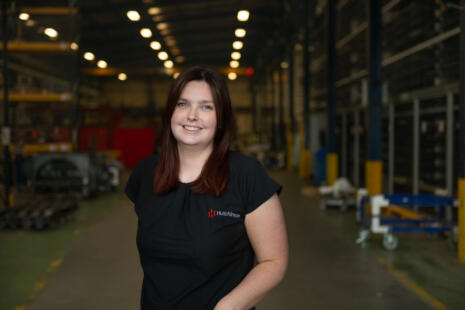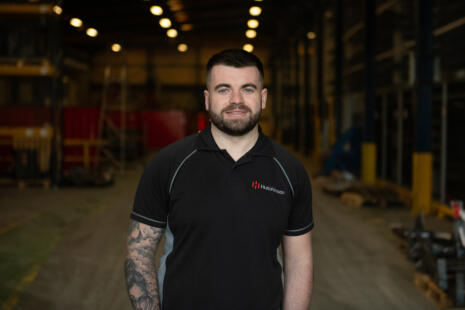From Hutchinson to McLaren F1 - Meet Chris
While working towards his Master's Degree in Mechanical Engineering at Queen’s University Belfast, Chris joined the Hutchinson team on a year-long placement. Following his time at Hutchinson, Chris went on to gain a place on the McLaren Formula One graduate scheme. However, using skills he gained from his time with us, he was offered a permanent role in his first year! (Seriously, his words, not ours!)
What department did you work in at Hutchinson?
I had the pleasure of working in the design and manufacturing team alongside Ian Ferguson and Jonny Mullan. My lasting memory of that time is the three of us having the best time, learning and growing in a deeply encouraging environment. We had some cool projects come through at that time and I loved the autonomy I was given, I always had the space to play my part or take the lead for things when I wanted to. Of course, I was reaching hurdles every day, but Hutchinson’s ethos of embracing challenges and applying an engineering and problem-solving mindset, is invaluable in any engineering environment and this is one of the most important skills I have kept with me.
How long were you there? How did you come into the company? What was your course of study?
I was studying at Queens’ University Belfast at the time, working towards my Master's Degree in Mechanical Engineering, and seeing the value in industry experience I was keen to spend a year working in a well-respected engineering company before going back for my final year at university. The team from Hutchinson had attended the Queens’ careers fair and stood out to me as a good environment for me to learn. I applied for a placement year, interviewed with Ian and was delighted to be offered the job.
What subjects did you study at school and why did you choose engineering?
I was always more of a numbers person and had my eye on engineering from a young age. I enjoyed tinkering with things, taking them apart and seeing what’s in there. It makes me feel old saying this but I must have had multiple VHS tapes of “Scrapheap Challenge” recorded off Channel 4. Those traits made it obvious that Engineering would be a good path for me so I leaned into Maths and Physics at School. At the same time, I was (and still am) massively into Music, I’d performed at the Royal Albert Hall in my last summer at school so found that keeping this on as a subject was a great way to stay balanced.
Describe your career path to date?
After spending my year with Hutchinson, I was confident that engineering was the right fit for me. Meanwhile, I was always a fan of Formula One, growing up watching it with my dad. I was 13 when Lewis Hamilton won his dramatic first championship with McLaren in 2008 and I can clearly remember watching that last lap. So putting those two together, I applied for an operations engineering graduate scheme at the McLaren Formula One team, and after flying over to England for an assessment day, giving it my all in a presentation, I was offered the chance to move to Woking, and become part of the team. I never intended to leave Northern Ireland, I have always had a deep love for where I live and I have a great network and roots here, but I knew this was an incredible opportunity, and I was keen to grasp it with both hands.
What did your role consist of at McLaren?
I joined to take part in what was supposed to be a 2-year operations graduate scheme, however, after quickly finding my feet on composite bodywork components and displaying some of the small batch manufacturing project management I’d picked up at Hutchinson, I was offered a permanent role within my first year. As part of my role in the project management team, I’d ensure the necessary timelines needed to hit specific races or events were met, or if not, how we could recover to give us the best chance on track whether it be close to home at Silverstone or to any of the several fly-aways such Australia, Brazil, Canada. I loved the mix of top-level management and getting down into the details when trying to overcome a problem. Some days you’d be hosting a kick-off meeting for a new Front Wing project and the next you’d be trying to understand how we can redesign a vacuum bag to hold a better vacuum whilst the carbon fibre is going through its high-pressure cure. My favourite part of the job was probably whizzing around the shopfloor, staying on top of the critical path parts for each project, keeping ahead of issues as they arose and most importantly in my view, maintaining good relationships with the highly skilled men and women that work around the manufacturing areas. I’ve learnt that firstly I am a people person and I have been able to lean on that in challenging environments.
What kind of projects did you work on?
I was responsible for mostly carbon fibre assemblies during my time at McLaren, I started on bodywork parts like Sidepods and Engine Covers, and then progressed into more complicated impact structures like Nosebox and then my favourite was probably the Front Wing and Rear Wings. My favourite, mainly because of how crucial those particular aero surfaces can be and therefore play such a big role in car performance. After being designed, a front wing can be manufactured in ~ 3 weeks if you’re at full pace and pulling out all the stops to get it to a specific race. Front Wings are much simpler than they used to be due to the sporting rules, however, there are still upwards of 200+ subcomponents that go into a full assembly, ranging from super lightweight rohacell cores to intricate titanium brackets with various surface treatments or heat treatments. I think one of the biggest misconceptions about Formula One and the cars that show up at a race weekend is that the cars are new for each event or there are unlimited parts if you have an accident. This just isn’t the case as the parts are so expensive to make and especially with the new cost cap era, stock levels are managed by the project management team, ensuring that we have the best balance but if you have a few bad weekends, you can run out easily as emergency parts can still take time because of the hand-made nature of the composite manufacturing process.
What skills did you learn at Hutchinson that were the most useful to you at McLaren?
Hutchinson is a small-batch, high-variety manufacturer that carries out a lot of Research and Development. McLaren is similar in that regard. There is a similar mindset of making bespoke components with lots of customization and often under the pressure of having to get it right the first time. I found skills coming across from both environments, trialling new manufacturing methods that give the best, strength, finish, geometry, and whatever characteristic is deemed most important to that component. The meticulous planning, thinking through the manufacture of a project ahead of time to anticipate anything that could go wrong.
What skills did you learn at Hutchinson that were the most useful to you in your subsequent career?
Something that I picked up at Hutchinson that I will continue to use in any engineering environment is how valuable it is to have good relationships across the manufacturing landscape. All too often across a manufacturing environment, we have office-based engineering staff who will rarely wander out onto the shopfloor and simply be curious. Asking questions, learning and collaborating where the action is happening.
What skills do you think a person needs to carve out a successful career in engineering?
I think showing intentional curiosity is a really good way to stand out. Intentional curiosity can be applied to anything, look at any object, a tyre, a front headlight, or a parcel shelf and think of how it could be manufactured, and if you can’t figure it out, look it up! The internet is amazing these days and I’m confident there will be information which explains how to make just about anything. Curiosity is nothing without being able to demonstrate a strong work ethic and being able to think critically, every engineer should be able to do that.
So what’s next for you?
Like I said earlier, I’ve always loved Northern Ireland and recently made the move with my wife, Sarah, to enjoy the next chapter of life closer to home. Along with that comes a new opportunity for me as a Project Manager with Artemis Technologies in Belfast, a world-leading high-performance maritime design and applied technologies company with a mission to decarbonise the maritime industry. Artemis Technologies develops 100% electric, carbon fibre, hydro-foiling vessels. I’m elated to find a challenging role working on such an exciting product and can’t wait to make a start.
Share this article
Latest Articles


